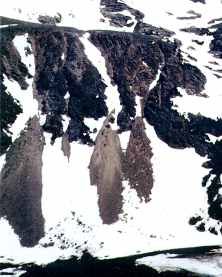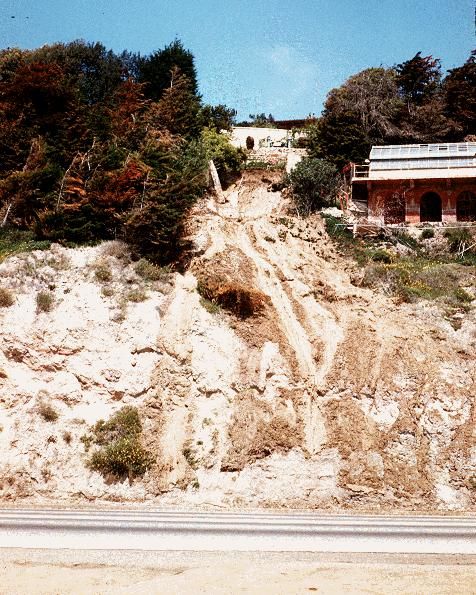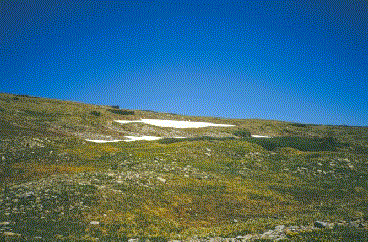Introduction to Mass Wasting
Mass wasting is a natural result of weathering on slopes. Simply put, gravity pulls loose rock and soil downhill.
Mass wasting is the process of erosion whereby rock, soil, and other earth materials move down a slope because of gravitational forces. It proceeds at variable rates of speed and is largely dependent on the water saturation levels and the steepness of the terrain. A destructive, rapid mass-wasting event is called a
landslide; if the movement is slow enough that it cannot be seen in motion, it is called
creep.
Three kinds of movement are generally recognized: flow, slip, and fall. A mass-wasting event is called a
flow if the mass moves downslope like a viscous fluid. If the mass moves as a solid unit along a surface or plane, it is called a
slip. A slip that moves along a surface parallel to the slope is called a
slide. If the movement occurs along a curved surface where the downward movement of the upper part of the mass leaves a steep scarp (cliff) and the bottom part is pushed outward along a more horizontal plane, it is called a
slump. Earth material that free-falls from a steep face or cliff is termed a
fall.
Mass‐Wasting Controls
A variety of conditions affect the development of mass wasting in a particular area. Steep slopes, widely varying altitude ranges (relief), the thickness of the loose earth material, planes of weakness parallel to the slopes, frequent freezing and thawing, high water content in the earth material, dry conditions with occasional heavy rainfall, and sparse vegetation are the factors that contribute to the unstable conditions that result in mass wasting. Movements can be triggered by the motion of earthquakes or too much weight added to the upper part of a slope, such as snowpack.
Angle of repose. The angle of repose is the steepest angle at which loose material will remain in place. It is largely dependent on the size, shape, and roughness of the particles. The angle varies from about 25 degrees to about 40 degrees. If the angle is exceeded by additional sedimentation or tilting, a slide or disturbance will result.
Gravity and friction. Rock particles and soil move downslope because of the forces of gravity. The gravity that acts on an object is a combination of the normal force and the shear force. The
normal force is perpendicular to the slope the object rests on, and the shear force is parallel to the surface of the slope (Figure 1 ). Steep slopes have high
shear forces; the steeper the slope, the greater the chance an object will slide. Friction, such as that from a rough bedrock surface, counteracts shear force. Rough, angular particles maintain steeper slopes than smooth rounded particles do. Water acts as a lubricant and reduces the force of friction, increasing the tendency to slide.
The shear strength is an object's resistance to movement that needs to be overcome in order to make it move. Shear strength is proportional to how solid the mass is, the density of plant roots, the amount of water present, and the roughness of the particles in the mass.
The effects of water. In addition to acting as a lubricant, water increases the weight of a mass of earth material. Water reduces the shear strength by forcing sediment particles apart through pore pressure, which reduces the friction between the particles. Alternatively, smaller amounts of water that don't completely fill the pores are distributed as thin films around the sediment particles, which are attracted to each other through surface tension, increasing the cohesiveness of the mass. Thus, saturated materials are much more likely to flow than a mass that is only a little wet.
Types of Mass Wasting
Rockfalls and rockslides.
Rockfalls occur when pieces of rock break loose from a steep rock face or cliff. These result from the rock face being undercut by rivers or wave action. Frost wedging may also eventually loosen large blocks, causing them to fall. The accumulation of rock debris at the base of a steep slope is called
talus.
 TALUS
Rockslides
TALUS
Rockslides usually follow a zone of weakness, such as a bedding plane or foliation plane. Separation of the rock is more likely along these planes because of their reduced shear strength. Water also tends to be channeled along these planes, which increases slippage. Collisions down the slope generally break the rock mass into rubble that eventually comes to rest. If steep slopes are involved, a fast-moving
rock avalanche may result. The rockslide or rock avalanche loses energy and speed as it moves across more level terrain.
Debris flows. Debris flows are defined as mass-wasting events in which turbulence occurs throughout the mass. Varieties of these are called
earthflows, mudflows, and debris avalanches.
When earth material moves down a hillside as a fluidlike mass, it is called an
earthflow. These flows typically occur in humid areas on steep slopes with thick, clay-rich soil that becomes saturated with water during storms. The earthflow usually leaves a steep scarp behind where it separated from the hillside. Earthflows can be fast (a few hours) or slow (a few months). Velocities range from 1 millimeter per day to meters per day. Intermittent activity can continue for years as the earthflow continues to settle and stabilize. Earthflows typically have rounded, hilly fronts. A common trigger for an earthflow is the undercutting of the slope by erosion from wave action or rivers or by construction projects.

MUD FLOW
A
mudflow is a liquidy mass of soil, rock debris, and water that moves quickly down a well-defined channel. Generally viscous and muddy colored, it can be powerful enough to move large automobiles and buildings. Mudflows occur most often in mountainous semiarid environments with sparse vegetation and are triggered by heavy rainfall that saturates the loose soil and sediment. They are also the natural result of volcanic ash build-ups on flanks of volcanoes and of forest fires that have exposed the soil to rapid erosion. A mudflow originating on a volcanic slope is called a
lahar.
A variety of earthflow called
solifluction is the flow of watersaturated earth material over an impermeable surface such as permafrost. It occurs frequently in bitterly cold regions such as in Alaska or Canada. Springtime temperatures thaw only the first few feet of the frozen ground (the active layer), which becomes saturated quickly and slowly flows over the ever-frozen permafrost below. Solifluction can occur on even the gentlest of slopes. Not forceful enough to break apart the surface vegetation, the migrating material drags it along like a wrinkled green rug. The soil finally settles on level ground at the base.
 SOLIFLUCTION
SOLIFLUCTION
The deadliest variety of debris flow is the
debris avalanche, a rapidly churning mass of rock debris, soil, water, and air that races down very steep slopes. It has been theorized that trapped air may increase the speed of an avalanche by acting as a cushion between the debris and the underlying surface.
Creep. A slow, gradual movement of soil or regolith downhill over time is called creep. Velocities are typically less than a centimeter per year. Freezing and thawing contribute to soil creep by progressively moving soil particles down the hill. Creep is manifested at the surface by such things as tilted utility poles that become more out of alignment every year. Vegetation helps reduce the rate of soil creep.
Slump. Earth material that has moved as a unit along a curved surface is called
slump. A slumped mass of sediment is typically clay rich. Slump usually results when the geometrical stability of a slope is compromised by the undercutting of its base, such as by wave action, a meandering river, or construction.
 SLUMP
Prevention of Mass Wasting
SLUMP
Prevention of Mass Wasting
Proper design during construction projects can eliminate the potential for increased mass wasting. Human activities such as undercutting the base of the slope, adding weight to the upper part of the slope by building large structures, removing vegetation, and saturating the ground with water increase the risks of mass wasting. Engineering solutions include barriers and retaining walls, drainage pipes, terracing the slope to reduce the steepness of the cuts, and immediate revegetation. Rockfalls can be controlled or eliminated by the use of rock bolts, cables, and screens and by cutting back slopes to lesser gradients.